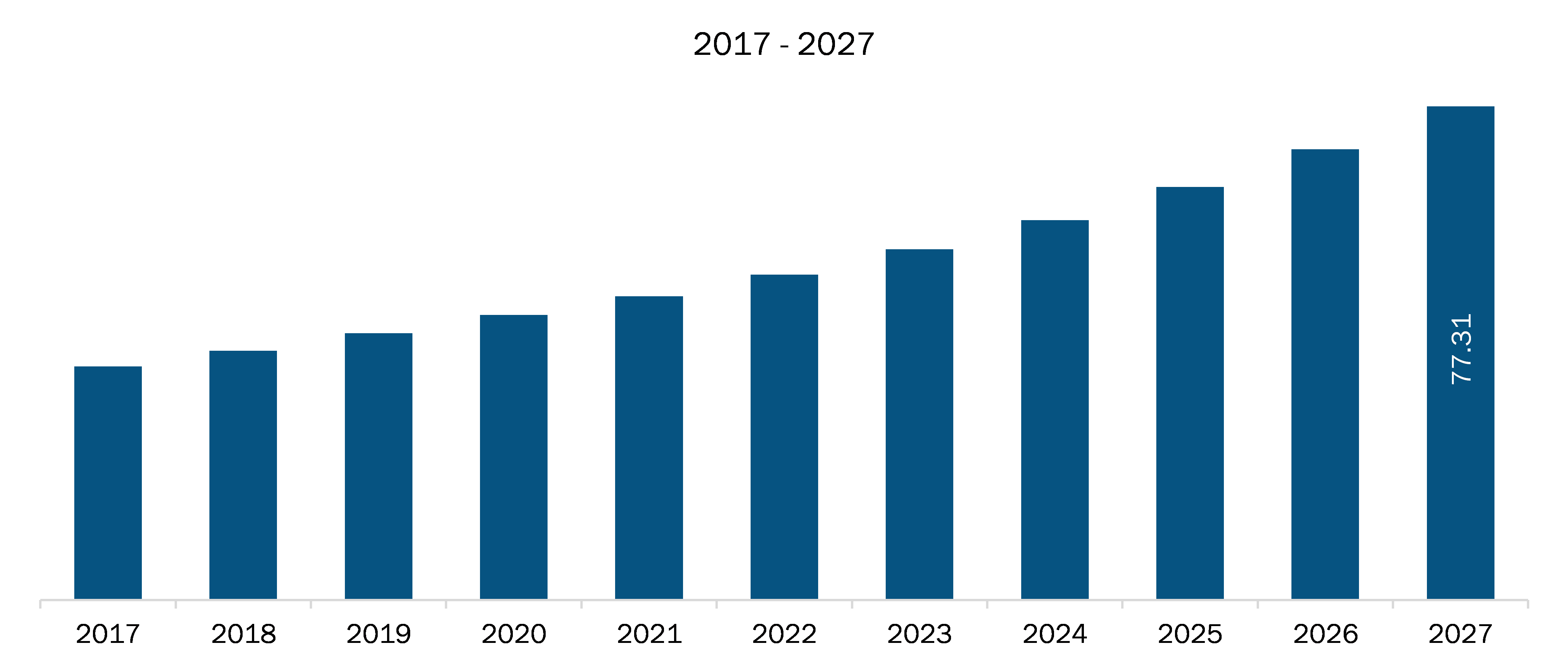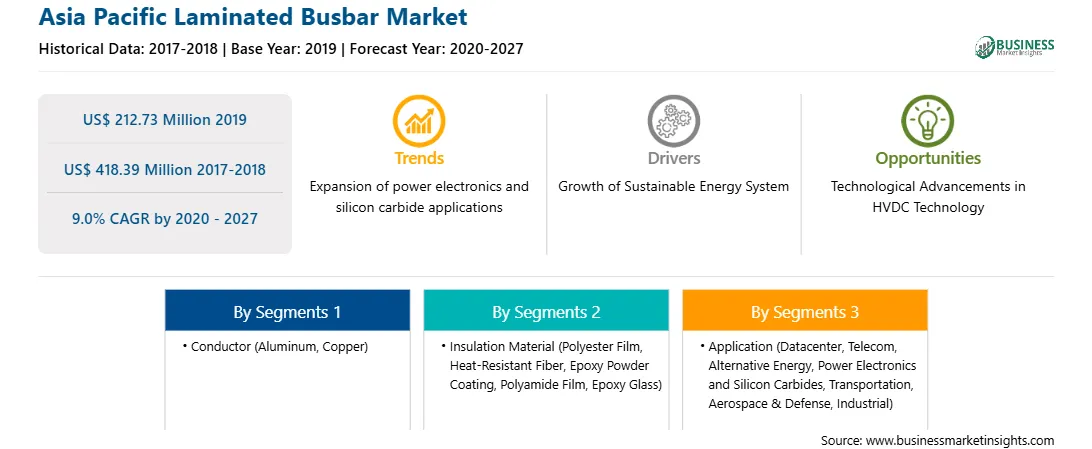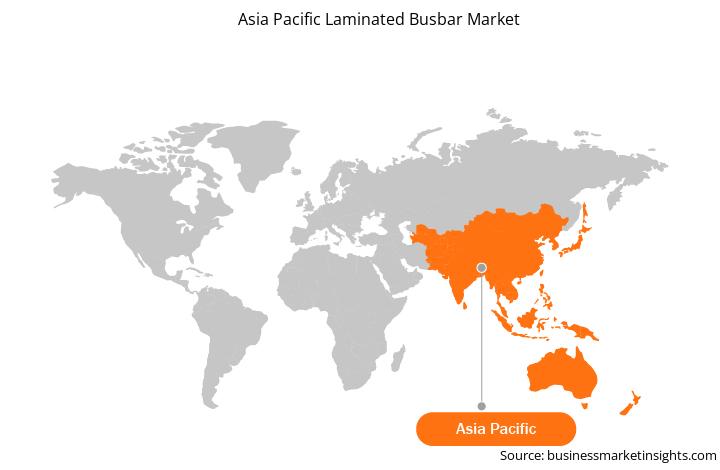Laminated busbar is an engineered component comprising layers of fabricated metal separated with very thin dielectric materials, laminated into a unified structure. Busbars support in reducing the overall system costs, improving the capacitance, enhancing reliability, and eliminating any wiring errors. Busbars also support in lowering the inductance and impedance in the system. The physical structure of the busbars offers exceptional features for mechanical design. One of the most common concerns with the conventional busbar is installation issues. The conventional ones consist of a complicated network of cables and interconnected parts that are difficult to assemble. On the other hand, laminated busbars are pre-assembled and have a compact structure. Geographically, the Asia Pacific market is segmented into China, India, Japan, South Korea, Australia, and the Rest of APAC. Asia Pacific is projected to witness the fastest growth during the forecast period. India and China are the most significant contributors to the laminated busbar market growth. The presence of other countries, such as Australia, Japan, and South Korea, also plays a crucial role in market growth. Several semiconductor and electronic component manufacturers, as well as HVDC providers, are aiming to deploy their solutions in APAC. For instance, in 2019, ABB Ltd. won a contract worth US$ 640 million from Power Grid Corporation of India Limited, the country’s national electricity grid operator. As per the contract, ABB is projected to supply an 800 kilovolt (kV) ultra-high-voltage direct current transmission link of more than 1,800 km to provide electricity to over 80 million people.
Since the outbreak of COVID-19 across Asia Pacific, several countries have suffered heavily. A few countries, such as China, Japan, South Korea, Australia, Hong Kong, and Taiwan, have incurred a huge loss. Manufacturing sectors in these countries have been experiencing low production and a weak supply chain. Additionally, labor shortage has affected the manufacturing sector in these countries. The manufacturing facilities across industries are foreseen to revive substantial production volumes by 2021, which is anticipated to create the demand for laminated busbars.

Strategic insights for the Asia Pacific Laminated Busbar provides data-driven analysis of the industry landscape, including current trends, key players, and regional nuances. These insights offer actionable recommendations, enabling readers to differentiate themselves from competitors by identifying untapped segments or developing unique value propositions. Leveraging data analytics, these insights help industry players anticipate the market shifts, whether investors, manufacturers, or other stakeholders. A future-oriented perspective is essential, helping stakeholders anticipate market shifts and position themselves for long-term success in this dynamic region. Ultimately, effective strategic insights empower readers to make informed decisions that drive profitability and achieve their business objectives within the market.

| Report Attribute | Details |
|---|---|
| Market size in 2019 | US$ 212.73 Million |
| Market Size by 2027 | US$ 418.39 Million |
| Global CAGR (2020 - 2027) | 9.0% |
| Historical Data | 2017-2018 |
| Forecast period | 2020-2027 |
| Segments Covered |
By Conductor
|
| Regions and Countries Covered | Asia-Pacific
|
| Market leaders and key company profiles |
The geographic scope of the Asia Pacific Laminated Busbar refers to the specific areas in which a business operates and competes. Understanding local distinctions, such as diverse consumer preferences (e.g., demand for specific plug types or battery backup durations), varying economic conditions, and regulatory environments, is crucial for tailoring strategies to specific markets. Businesses can expand their reach by identifying underserved areas or adapting their offerings to meet local demands. A clear market focus allows for more effective resource allocation, targeted marketing campaigns, and better positioning against local competitors, ultimately driving growth in those targeted areas.

The laminated busbar market in Asia Pacific is expected to grow from US$ 212.73 million in 2019 to US$ 418.39 million by 2027; it is estimated to grow at a CAGR of 9.0% from 2020 to 2027. The growing adoption of smart grids and growth of sustainable energy system are driving the growth of laminated busbar market across the region. However, the complexity concerns with respect to laminated busbars is a hindering factor to the laminated busbar market growth. Furthermore, increase in demand for electric vehicles is expected to bolster the growth of the laminated busbar market in the near future.
In terms of conductor, the copper segment accounted for a larger share of the Asia Pacific laminated busbar market in 2019. In terms of insulation material, the polyester film segment held the largest market share in 2019. Further, based on application, power electronics and silicon carbides segment held the largest share of the market. Geographically, the market is categorized into China, India, Japan, South Korea, Australia, and the Rest of APAC. China held the largest share of the laminated busbar market.
A few major primary and secondary sources referred to for preparing this report on the laminated busbar market in Asia Pacific are company websites, annual reports, financial reports, national government documents, and statistical database. Major companies listed in the report are Electronic Systems Packaging LLC (ESP), Methode Electronics, Inc., Ryoden Kasei CO., Ltd., Suzhou West Deane Machinery Inc., OEM International AB, Zhuzhou CRRC Times Electric Co., Ltd., Mersen SA, Rogers Corporation, and Amphenol Corporation, among others.
The Asia Pacific Laminated Busbar Market is valued at US$ 212.73 Million in 2019, it is projected to reach US$ 418.39 Million by 2027.
As per our report Asia Pacific Laminated Busbar Market, the market size is valued at US$ 212.73 Million in 2019, projecting it to reach US$ 418.39 Million by 2027. This translates to a CAGR of approximately 9.0% during the forecast period.
The Asia Pacific Laminated Busbar Market report typically cover these key segments-
The historic period, base year, and forecast period can vary slightly depending on the specific market research report. However, for the Asia Pacific Laminated Busbar Market report:
The Asia Pacific Laminated Busbar Market is populated by several key players, each contributing to its growth and innovation. Some of the major players include:
The Asia Pacific Laminated Busbar Market report is valuable for diverse stakeholders, including:
Essentially, anyone involved in or considering involvement in the Asia Pacific Laminated Busbar Market value chain can benefit from the information contained in a comprehensive market report.